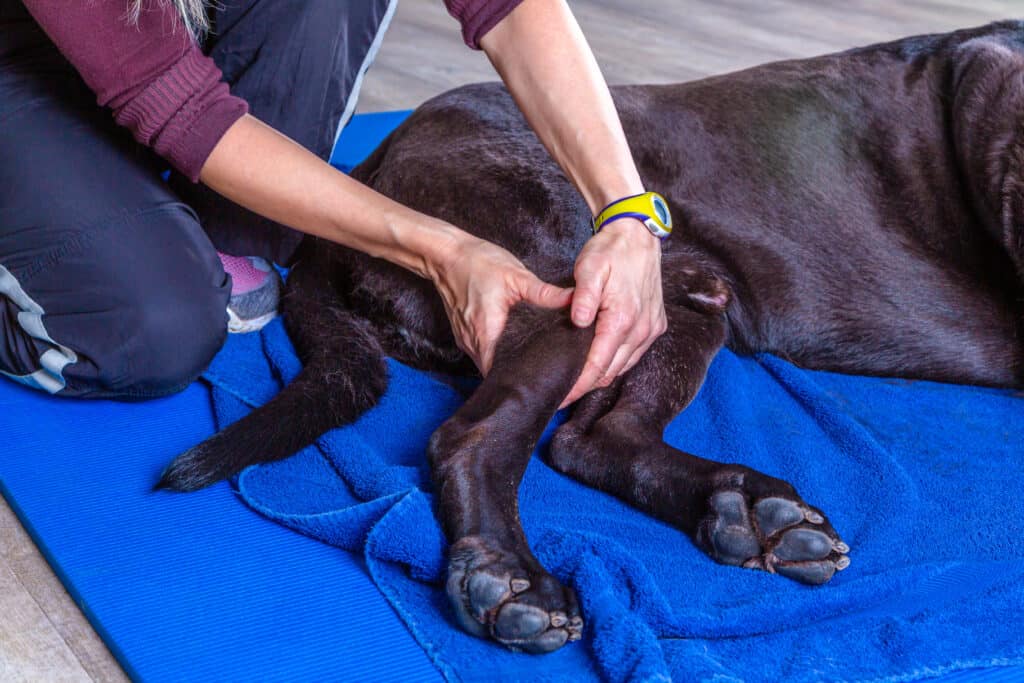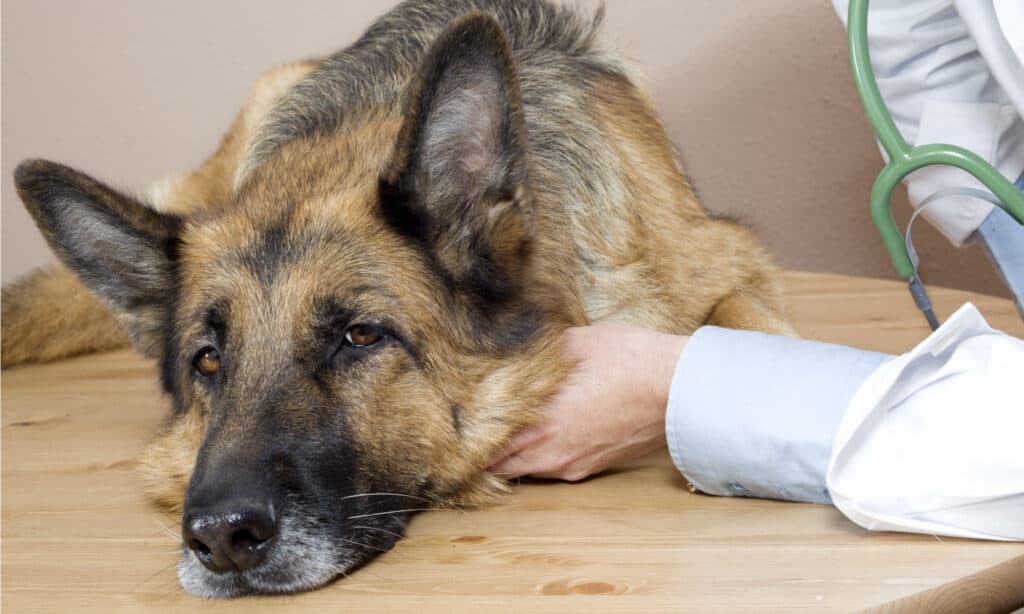Just as you and I can injure our knees unexpectedly, so can our canine friends. Ranging from soft tissue injuries to painful bone fractures, our pups can experience it all!
If your pup has fallen victim to a painful knee injury, they may require surgery to repair their damaged knee. Though your vet will discuss your dog’s treatment options in detail, we’re here to break down all the options!
Whether your dog has a soft tissue injury or a bone injury, let’s dive into everything you need to know!
The Structures Within a Dog’s Knee

There are many important structures within the canine knee that are essential for stability.
©msgrafixx/Shutterstock.com
There are different structures within the canine knee that are most commonly injured.
Patellar ligament: The patellar ligament is the structure that sits on top of the dog’s kneecap. This ligament is connected to both the thigh muscles and the center of the shin. This is what helps the leg extend and straighten when needed.
Patella: The patella, or the kneecap, protects the joints within the knee. It also provides leverage as the pup bends and straightens his leg.
Medial meniscus: The medial meniscus is a small disc located within the femoral condyle and the tibial condyle. This structure helps absorb stress that occurs across the joint and stabilize the knee joint. It also prevents friction between the head of the femur and tibia.
Cranial cruciate ligament: Similar to the ACL in humans, the cranial cruciate ligament provides essential support to the knee. The CCL allows for subtle movement within the knee, so when it is injured, the knee becomes unstable.
How Do Dogs Injure Their Knee?
Though many factors could lead to a knee injury in dogs, a few scenarios seem to be most common. According to veterinary professionals, some of the most common situations that lead to a knee injury include:
- Accidently stepping in a hole while running
- Sudden twisting of the knee joint, typically occurring when a dog suddenly changes directions while running
- Jumping off a high surface and landing on their feet
- Falling off a high surface and landing on their feet
- Some type of blunt force trauma to the knee
- Growth issues due to improper breeding, as this can lead to deterioration of the structures within the knee
- Previous knee injuries that have led to joint deterioration
We always suggest having your pup assessed by a vet if they are experiencing any signs of knee discomfort.
Signs Of a Knee Injury in Dogs
Our dogs cannot tell us they are in pain, so it’s up to us to lookout for any discomfort. Let’s discuss the most common signs of a canine knee injury.
Signs and symptoms of a knee injury in dogs include:
- Sudden limping, ranging in severity to putting a small amount of weight on the limb to none at all
- Hearing your dog suddenly cry out during any type of activity
- Swelling of the knee or the surrounding areas
- Not using one of their back legs or skipping on the leg when running
- Sensitivity of the limb, or not allowing anyone to touch it
- Hearing clicks coming from the limb when they are walking
- Thickening of the knee joint over time
- Sitting with one of their back legs straight out instead of allowing it to bend
- Disinterest in physical activity
Our canine friends can express pain in many different ways. We always suggest reaching out to your vet if you think your canine friend is experiencing leg discomfort. Even if symptoms seem minor, it’s always best to be safe and have them assessed. Minor knee injuries can worsen over time if they are not addressed early on.

Dogs can injure their knee in scenarios ranging from tripping in holes to jumping off high surfaces.
©Roger costa morera/Shutterstock.com
Let’s break down the most common knee surgeries in dogs based on injury. We’ll discuss the most common surgical methods for each ailment.
Patellar Luxation Surgical Repair
As we mentioned above, the patellar ligament sits on top of the dog’s kneecap. This ligament attaches to the thigh muscles and the center of the dog’s tibia. However, if it is not centered properly, this can cause the kneecap to slip out of place. This essentially leads to the dislocation of the dog’s kneecap. This can lead to pain and damage to the knee joint over time. If your vet recommends surgery for your dog’s luxating patella, there are a few different approaches they can explore.
In most cases, they will decide between soft tissue surgery and surgery involving the bones. The most common soft tissue procedures include a lateral imbrication, antirotational sutures, and a medial desmotomy. Each of these procedures involve either tightening or loosening the surrounding knee tissues. But this all depends on the structure of your dog’s knee. If their surgery of choice involves manipulating the bone, they will typically either cut and adjust the bone to a more appropriate position, or they will deepen the trochlear groove to better accommodate the patella.
Torn CCL Surgical Repair
If your dog has a torn CCL, your vet will likely determine their surgical approach by the severity of the injury. Your dog’s size will also be a factor. After assessment, they will likely decide between a TPLO, a TTA, or a LSR. To make sure you understand what lies ahead for your pup, let’s breakdown each type of dog CCL surgery.
TPLO
A TPLO involves the veterinary surgeon removing the damaged portions of your dog’s CCL. They will then make a small incision near your dog’s tibia, rotate the tibial plateau, and secure it with surgical plates and screws. This is used most often in large breed dogs.
TTA
A TTA involves a small incision in the dog’s tibial tuberosity, and then repositioning of the tibia itself. This will help the ligaments better align with the dog’s patella. They will then secure the new position in place with surgical plates and screws. This is used most often in medium sized dogs.
Lateral Suture Repair
A Lateral Suture Repair is a procedure in which the veterinary surgeon creates an anchor within the knee. They do this by placing a suture on the outside of the dog’s knee joint and passing this suture around the back of the dog’s femur. They then feed this suture into a hole they drill into the tibial tuberosity, before securing it in place. The dog’s body will then form scar tissue around the suture, and ultimately create the stable anchor within the knee. This is typically only used in small breed dogs.
If your dog fractures any components of their knee joint, this may require surgery as well. These injuries are complex and require individualized care. We suggest getting the details of their procedure from your veterinary team.
Does My Dog Need Knee Surgery?
If your dog has fallen victim to a knee injury of any kind, you may be wondering if surgery is the only option. While many knee injuries will require surgical repair, some can be managed with strict exercise restrictions, knee braces, and anti-inflammatory medications.
Some dogs may even have the option of exploring conservative care before diving into surgery. But this will vary from case to case. Your vet is the only one that knows the details of your dog’s injury. Trust your vet’s guidance when it comes to whether or not they need surgery.
Final Thoughts
Our canine companions can fall victim to many forms of knee injury, which is why there are a variety of surgical repair options on the table. Your dog’s ideal knee surgery will vary based on the form and severity of their injury, so we always suggest trusting your vet’s guidance when it’s time to determine a treatment plan.
The photo featured at the top of this post is © Andy Gin/Shutterstock.com
Ready to discover the top 10 cutest dog breeds in the entire world?
How about the fastest dogs, the largest dogs and those that are -- quite frankly -- just the kindest dogs on the planet? Each day, AZ Animals sends out lists just like this to our thousands of email subscribers. And the best part? It's FREE. Join today by entering your email below.
Thank you for reading! Have some feedback for us? Contact the AZ Animals editorial team.






